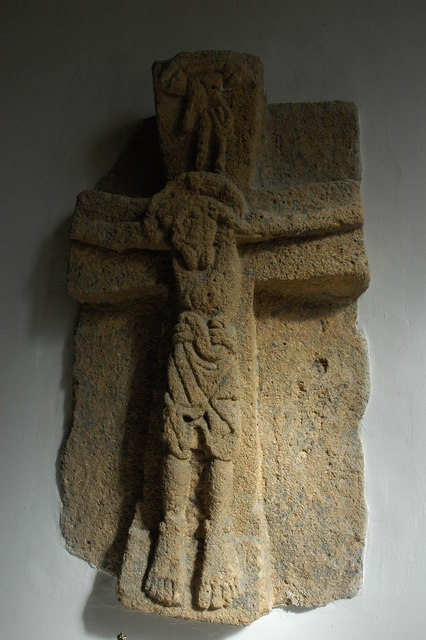By Kim Rendfeld
The story of Cynehelm and Cwenthryth has envy, sibling rivalry, lust for power, murder, and divine justice. Too bad it’s just not true.According to an 11th-century passio (account of martyrdom), Mercian King Cenwulf died in 819, and his realm passed to his 7-year-old son, Cynehelm (also spelled Kenelm). Lusting for power, Cwenthryth persuaded Cynehelm’s tutor to decapitate the child while the young king was hunting. Cwenthryth got the crown, but a dove miraculously delivered a parchment to the pope, telling him where Cynehelm was buried. The pope sent a delegation, led by Wulfred, archbishop of Canterbury, to recover the body and have it enshrined at Winchcombe. Apparently, Cwenthryth was not satisfied with her brother’s death; she wanted to curse him. So she read the psalter backward as the procession passed by her window. Her eyes, literally, dropped to the page, and she soon died in disgrace.
Any resemblance between this tale and actual history is purely coincidental.
 |
| Sculpture of St. Kenelm (photo by Sjukmidlands, CC BY-SA 4.0, via Wikimedia Commons) |
The real Cwenthryth was the daughter of King Cenwulf, who reigned from 796 to 821. She did witness a charter as the king’s daughter in 811, the same year Wulfred dedicated a church at Winchcombe.
Cenwulf, who claimed descent from Penda’s brother, had succeeded Offa’s son Ecgfrith, whose death might not have been from natural causes. Offa had a reputation for ruthlessness (Alcuin said Ecgfrith paid for his father’s sins). But Cenwulf had his moments. Early in his reign, he suppressed a rebellion in Kent and had its leader blinded and his hands chopped off. He released his crippled rival to Winchcombe, an abbey Cenwulf had founded in 798 and a center of power.
If Cynehelm was Cenwulf’s son—it is possible with such similar names—Cynehelm preceded his father in death. When Cenwulf died in 821 (two years after the legend says he did), the king did not have a male heir, and his brother Coelwulf ascended to the throne.
 |
| Coins with Cenwulf's image (drawing by DrKay, public domain, via Wikimedia Commons) |
If she had a living brother, Cwenthryth likely would have wanted him remain alive and influence him. What happened to Cwenthryth raises a more nuanced question: Why did she become an abbess? As a late king’s daughter and current king’s niece, and one with ties to a dynasty, she would have been a desirable bride. Marriage was a way for noble families to forge alliances. Yet kings sometimes gave daughters to the Church as a thanksgiving for a victory in battle. Did Cwenthryth herself feel pulled to the religious life? Or did she simply not want a husband ordering her around?
As the abbess of Winchcombe, as well as Reculver and Minster-in-Thanet in Kent, she led communities and controlled land. And she was determined to keep control of those properties.
When her father died, Cwenthyth inherited a years-long dispute between Cenwulf and Wulfred (who happens to be one of the good guys in the legend). At the center was who controlled the Kentish churches. Wulfred had reached an agreement with Cenwulf shortly before the monarch died and expected those properties.
Wulfred was a powerful churchman, having anointed Cwenthryth’s uncle Coelwulf as king, but Cwenthryth did not give in to the archbishop’s demand for rent or her obedience.
Unfortunately for Cwenthryth, Coelwulf had a short reign. He was deposed in 823. Perhaps Wulfred saw an opportunity in the new king, Beornwulf. But he underestimated Cwenthyth.
Finally, Wulfred filed a lawsuit against her in 825, demanding those two church properties in Kent and submission from Cwenthryth. Beornwulf was less sympathetic to Cwenthryth and ruled against her, but before she surrendered the Kentish lands, she managed to drag out the process until 827, a year after Beornwulf was killed by East Angles.
Cwenthryth disappears from the historical record after 827. She likely remained abbess at Winchcombe for the rest of her life, and the abbey might have passed to her cousin Ælfflæd, daughter of Coelwulf.
 |
| Photo by Philip Halling, CC BY-SA 2.0, via Wikimedia Commons |
So why defame Cwenthryth? Her defiance to a male authority did not make her an ideal woman in medieval eyes, but she wasn’t a murderer.
Like some historical fiction such as The Song of Roland, the passio might have been more about the times it was written in. The 11th century story might reflect the culture of England right before the Norman Conquest. It is similar to Edward the Martyr—a young king killed by treachery of female relative.
Winchcombe, where Cynehelm is interred, might have become a center for pilgrims who wished to pray before a martyr’s relics. Its cathedral was rededicated twice between 970 and 1070. The first was for an Anglo-Saxon revival; the second, to introduce the Norman church.
A religious story like a hagiography or a passio is meant to be a tale of faith rather than a literal historical record. In this case, it might be the message of divine punishment and spiritual blindness manifesting as a physical one.
Sources
Oxford Dictionary of National Biography, including
“Cenwulf” by M.K. Lawson
“Cwenthryth” by S.E. Kelly
“Beornwulf” by S.E. Kelly
“Cynehelm [St Cynehelm, Kenelm]” by David Rollason
“Wicked Queens and Martyred Kings – the 819 Murder of S. Kenelm of Mercia,” The Postgrad Chronicles
~~~~~~~~~~
Connect with Kim at on her website kimrendfeld.com, her blog, Outtakes of a Historical Novelist at kimrendfeld.wordpress.com, on Facebook at facebook.com/authorkimrendfeld, or follow her on Twitter at @kimrendfeld.

No comments:
Post a Comment
Note: Only a member of this blog may post a comment.